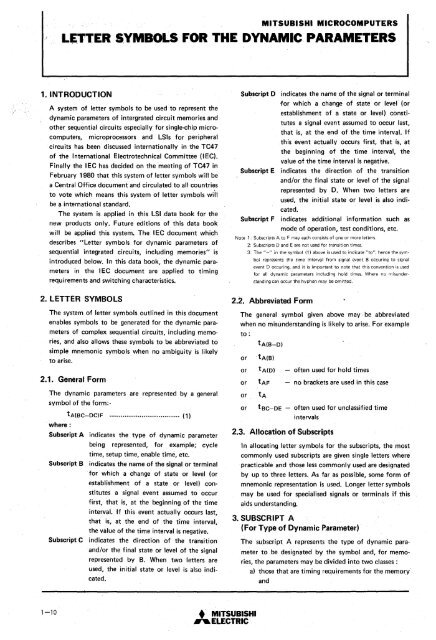mitsubishi - Al Kossow's Bitsavers
mitsubishi - Al Kossow's Bitsavers
mitsubishi - Al Kossow's Bitsavers
You also want an ePaper? Increase the reach of your titles
YUMPU automatically turns print PDFs into web optimized ePapers that Google loves.
MITSUBISHI MICROCOMPUTERSLE,:lTER SYMBOLS FOR THE DYNAMIC PARAMETERS1. INTRODUCTIONA system of letter symbols to be used to represent thedynamic parameters of intergrated circuit memories andother sequential circuits especially for single-chip microcomputers,microprocessors and LSls for peripheralcircuits has been discussed internationally in the TC47of the International Electrotechnical Committee (I ECI.Finally the IEC has decided on the meeting of TC47 inFebruary 1980 that this system of letter symbols will bea Central Office document and circulated to all countriesto vote which means this system of letter symbols willbe a international standard.The system is applied in this LSI .data book for thenew products only. Future editions of this data bookwill be applied this system. The IEC document whichdescribes "Letter symbols for dynamic parameters ofsequential integrated circuits, including memories" isintrod4ced below. In this data book, the dynamic parametersin the I EC document are applied to timingrequirements and switching characteristics.2. LETTER SYMBOLSThe system of letter symbols outlined in this documentenables symbols to be generated for the dynamic parametersof complex sequential circuits, including memories,and also allows these symbols to be abbreviated tosimple mnemonic symbols when no ambiguity is likelyto arise.2.1. General FormThe dynamic parameters are represented by a generalsymbol of the form:-where:tA(BC-DC)F ...•........•.•..•.....•............• (1)Subscript A indicates the type of dynamic parameterbeing represented, for example; cycletime, setup time, enable time, etc.Subscript B indicates the name of the signal or terminalfor which a change of state or level (orestablishment of a state or level) constitutesa signal event assumed to occurfirst, that is, at the beginning of the timeinterval. If this event actually occurs last,that is, at the end of the time interval,the value of the time interval is negative.Subscript C indicates the direction of the transitionand/or the final state or level of the signalrepresented by B. When two letters areused, the initial state or level is also indicated.Subscript 0 indicates the name of the signal or terminalfor which a change of state or level (orestablishment of a state or level) constitutesa signal event assumed to occur last,that is, at the end of the time interval. Ifthis event actually occurs first, that is, atthe beginning of the time interval, thevalue of the time interval is negative.Subscript E indicates the direction of the transitionand/or the final state or level of the signalrepresented by D. When two letters areused, the initial state or level is also indicated.Subscript F indicates additional information such asmode of operation, test conditions, etc.Note 1: Subscripts A to F may each consists of one or more letters.2: Subscripts D and E are not used for transition times.3· The "-" in the symbol (1) above is used to indicate "to"; hence the symbolrepresents the time interval from signal event B occuring to signalevent D occuring, and it is important to note that this convention is usedfor all dynamic parameters including hold times. Where no misunderstandingcan occur the hyphen may be omitted.2.2. Abbreviated FormThe general symbol given above may· be abbreviatedwhen no misunderstanding is likely to arise. For exampleto:ortA(B-D)·tA(B)or tA(D) often used for hold timesor tAF no brackets are used in this caseortAor tBC-DE often used for unclassified timeintervals2.3. <strong>Al</strong>location of SubscriptsIn allocating letter symbols for the subscripts, the mostcommonly used subscripts are given single letters wherepracticable and those less commonly used are designatedby up to three letters. As far as possible, some form ofmnemonic representation is used. Longer letter symbolsmay be used for specialised signals or terminals if thisaids understanding.3. SUBSCRIPT A{For Type of Dynamic P,arameter}The subscript A represents the type of dynamic parameterto be designated by the symbol and, for memories,the parameters may be divided into two classes:a) those that are timing requirements for the memo~iand1-10 • MITSUBISHI"ELECTRIC

















